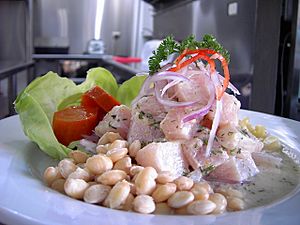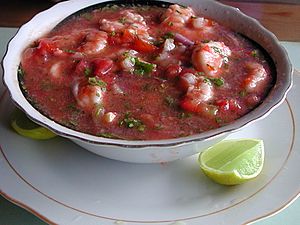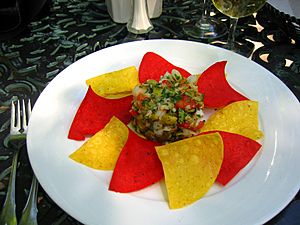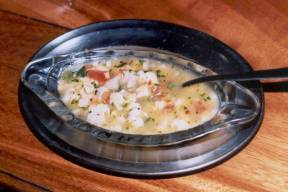Ceviche facts for kids
|
Peruvian ceviche
|
|
| Course | Main course, appetizer |
|---|---|
| Place of origin | |
| Serving temperature | Cold; cooked or raw (marinated) |
| Main ingredients | Fish, lime, lemon, onion, chili pepper |
Ceviche, also cebiche, seviche or sebiche, is the seafood dish originated in Peru typically made from fresh raw fish cured in citrus juices, such as lemon or lime, and spiced with ají, chili peppers or other seasonings including chopped onions, salt, and cilantro. Because the dish is not cooked with heat, it must be prepared and consumed fresh to minimize the risk of food poisoning. Ceviche is usually accompanied by side dishes that complement its flavors, such as sweet potato, lettuce, corn, avocado or plantain. The dish is popular in the Pacific coastal regions of Latin America. Though the origin of ceviche is hotly debated, in Peru it is considered a national dish.
Though archeological records suggest that something resembling ceviche may have been consumed in Peru nearly two thousand years ago, some historians believe the predecessor to the dish was brought to Peru by Moorish women from Granada, who accompanied the Spanish conquistadors and colonizers, and this dish eventually evolved into what is now considered ceviche. Peruvian chef Gastón Acurio further explains that the dominant position Lima held through four centuries as the capital of the Viceroyalty of Peru allowed for popular dishes such as ceviche to be brought to other Spanish colonies in the region, and in time they became a part of local cuisine by incorporating regional flavors and styles.
Ceviche is now a popular international dish prepared in a variety of ways throughout the Americas, reaching the United States in the 1980s. The greatest variety of ceviches are found in Ecuador, Colombia, Chile and Peru; but other distinctly unique styles can also be found in coastal Honduras, El Salvador, Belize, Guatemala, the United States, Mexico, Panama, and several other nations.
History
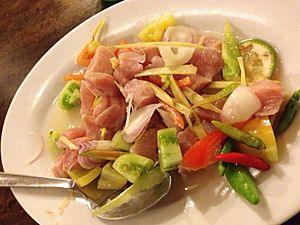
Marlin Kilawin from the Philippines
|
Various explanations of ceviche's origin exist. According to some historic sources from Peru, ceviche originated among the Moche, a coastal civilization that began to flourish in the area of current-day northern Peru nearly 2000 years ago. The Moche apparently used the fermented juice from the local banana passionfruit. Recent investigations further show that during the Inca Empire, fish was marinated with chicha, an Andean fermented beverage. Different chronicles also report that along the Peruvian coast prior to the arrival of Europeans, fish was consumed with salt and ají. Furthermore, this theory proposes that the natives simply switched to the citrus fruits brought by the Spanish colonists but that the main ingredients of the plate remained essentially the same. In Ecuador, ceviche may have also had its origins among its coastal civilizations since both Peru and Ecuador have shared cultural heritages (such as the Inca Empire) and a large variety of fish and shellfish.
The ancient kinilaw (or kilawin) dish of the Philippines is remarkably similar to ceviche and is another possible origin. It is the origin generally agreed upon in Mexico. Especially since citrus fruits, which are not indigenous to the Americas, are native to the Philippines. Kinilaw has numerous variations in the Philippines and has been attested from archaeological records from the 10th to the 13th century AD. It was also introduced to Guam (resulting in kelaguen), which was also situated along the Spanish-era trade route of the Manila Galleons.
The invention of the dish is also attributed to places ranging from Central America to the Polynesian islands in the South Pacific. Ceviche is not native to Mexico, despite the fact that the dish has been a part of traditional Mexican coastal cuisine for centuries. The Spanish, who brought citrus fruits such as lime from Europe, may have brought the dish from Spain, where ìt may have had roots in Moorish cuisine.
Nevertheless, most historians agree that ceviche originated during colonial times in the area of present-day Peru. They propose that the predecessor to the dish was brought to Peru by Moorish women from Granada who accompanied the Spaniards and that this dish eventually evolved into what nowadays is considered ceviche. The Peruvian chef Gastón Acurio further explains that the dominant position that Lima held throughout four centuries as the capital of the Viceroyalty of Peru allowed for popular dishes such as ceviche to be brought to other Spanish colonies in the region and to eventually become a part of local cuisine by incorporating regional flavors and styles. Other notable chefs who support the Peruvian origin of the dish include the Chilean Christopher Carpentier and the Spaniard Ferran Adrià, who in an interview stated, "Cebiche was born in Peru, and so the authentic and genuine [cebiche] is Peruvian."
Images for kids
-
"Alaskan" Ceviche made with Pacific halibut, serrano peppers, cilantro and tomato
See also
 In Spanish: Cebiche para niños
In Spanish: Cebiche para niños


